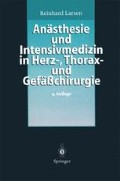Zusammenfassung
Die Wahl des richtigen Anästhetikums für Patienten mit Erkrankungen des Herz-Kreislauf-Systems ist umstritten, wenngleich die Anforderungen klar definiert sind: keine Beeinträchtigung des myokardialen O2-Gleichgewichts durch Blutdruckanstieg, Blutdruckabfall oder Tachykardie beim Koronarkranken; Aufrechterhaltung einer ausreichenden Myokardkontraktilität und Sympathikusaktivität bei globaler Herzinsuffizienz oder funktionell bedeutsamen Herzklappenfehlern. So ist einerseits bei Patienten mit koronarer Herzkrankheit häufig eine kontrollierte Dämpfung der Myokardkontraktilität und des sympathoadrenergen Tonus erforderlich, um eine Zunahme des myokardialen O2-Bedarfs durch unerwünschte kardiovaskuläre Reflexreaktionen auf anästhesiologische (z.B. endotracheale Intubation) und operative Stimuli (z.B. Sternotomie) zu verhindern. Andererseits dürfen bei Patienten mit globaler Herzinsuffizienz oder schweren Herzklappenfehlern der kompensatorisch erhöhte Sympathikotonus und die Myokardkontraktilität nicht beeinträchtigt werden, damit kein Abfall des Herzzeitvolumens und nachfolgend eine Mangeldurchblutung der Organe eintritt. Beide gegensätzlichen Anforderungen können naturgemäß weder durch Inhalationsanästhetika noch durch intravenöse Anästhetika oder Opioide gleichzeitig erfüllt werden, so daß beim Herzkranken gewöhnlich ein differenzierter Einsatz verschiedener Substanzen erforderlich ist, wenn nötig, ergänzt durch Sedativa, Vasodilatatoren, Vasopressoren, β-Blocker oder positiv-inotrop wirkende Medikamente.
Access this chapter
Tax calculation will be finalised at checkout
Purchases are for personal use only
Preview
Unable to display preview. Download preview PDF.
Literatur
Al-Khudhairi D, Gordon G, Morgan M, Whitwam JG (1982) Acute cardiovascular changes following disoprofol. Effects in heavily sedated patients with coronary artery disease. Anaesthesia 37:1007.
Buffington CW, Romson JL, Levine A et al. (1987) Isoflurane induces coronary steal in a canine model of chronic coronary occlusion. Anesthesiology 66:280.
Chong JL, Grebenik C, Sinclair M, et al. (1993) The effect of a cardiac surgical recovery area on the timing of extubation. J Cardiothor Vasc Anesth 7:137.
Ferres CJ, Carson IW, Lyons SM et al. (1987) Haemodynamic effects of vecuronium, pancuronium and atracurium in patients with coronary artery disease. Br J Anaesth 59:305.
Larsen R, Rathgeber J, Bagdahn A et al. (1988) Effects of propofol on cardiovascular dynamics and coronary blood flow in geriatric patients. A comparison with etomidate. Anaesthesia [Suppl] 43:25.
Larsen R, Lange H, Rathgeber J (1988) Myokardstoffwechsel unter Propofol bei geriatrischen Patienten. Ein Vergleich mit Etomidat. Anaesthesist 37:510.
Morris RB, Cahalan MK, Miller RD et al. (1983) The cardiovascular effects of vecuronium (ORG NC 45) and pancuronium in patients undergoing coronary artery bypass grafting. Anesthesiology 58:438.
Mulier JP, Wouters PF, van Aken H, et al. (1991) Cardiodynamics of propofol in comparison with thiopental: Assessment with a transesophageal echocardiographic approach. Anesth Analg 72:28.
Priebe HJ (1988) Isoflurane causes more severe regional myocardial dysfunction than halothane in dogs with critical coronary artery stenosis. Anesthesiology 69:72.
Reiz S, Balfors E, Sorensen MB et al. (1983) Isoflurane — a powerful coronary vasodilator in patients with coronary artery disease. Anesthesiology 59:91.
Salmenpara M, Peltola K, Takkunen O et al. (1983) Cardiovascular effects of pancuronium and vecuronium during high-dose fentanyl anesthesia. Anesth Analg 62:1059.
Shapiro BA (1993) Inhalation-based anesthetic techniques are the key to early extubation of the cardiac surgical patient. J Cardiothor Vasc Anesth 7:135.
Sill JC, Bove AA, Nugent M et al. (1987) Effects of isoflurane on coronary arteries and coronary arterioles in the intact dog. Anesthesiology 66:273.
Sonntag H, Larsen R (1986) Cardiovascular actions of narcotic analgesics. In: Altura BM, Halevy S (eds) Cardiovascular actions of anesthetics and drugs used in anesthesia, vol I. Karger, Basel, p. 74.
Stephan H, Sonntag H, Schenk HD et al. (1986) Effects of propofol on cardiovascular dynamics, myocardial blood flow and myocardial metabolism in patients with coronary artery disease. Br J Anaesth 48:969.
Author information
Authors and Affiliations
Rights and permissions
Copyright information
© 1995 Springer-Verlag Berlin Heidelberg
About this chapter
Cite this chapter
Larsen, R. (1995). Anästhetika und Adjuvanzien. In: Anästhesie und Intensivmedizin in Herz-, Thorax- und Gefäßchirurgie. Springer, Berlin, Heidelberg. https://doi.org/10.1007/978-3-662-05726-1_1
Download citation
DOI: https://doi.org/10.1007/978-3-662-05726-1_1
Publisher Name: Springer, Berlin, Heidelberg
Print ISBN: 978-3-540-59386-7
Online ISBN: 978-3-662-05726-1
eBook Packages: Springer Book Archive

